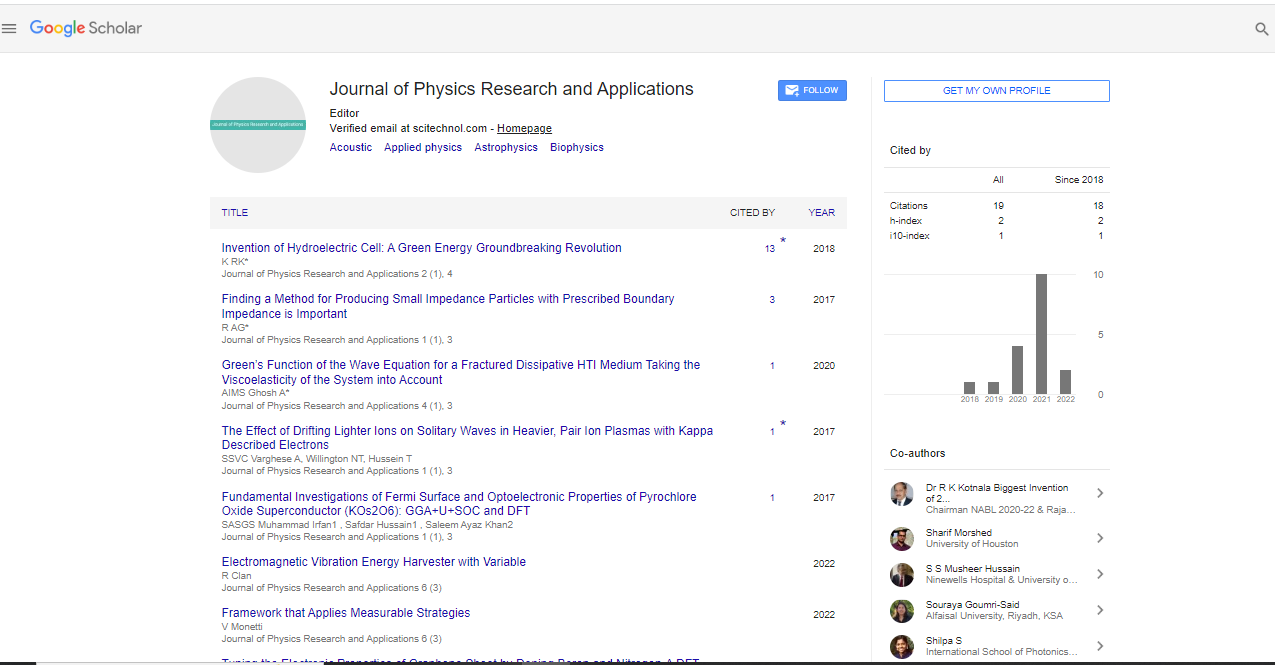Commentary, J Phys Res Appl Vol: 8 Issue: 2
Techniques and Applications of Interferometry in Astronomy for High-Resolution Imaging
Yubin Ryu*
1Department of Physics, Ewha University, Seoul, South Korea
*Corresponding Author: Yubin Ryu,
Department of Physics, Ewha University,
Seoul, South Korea
E-mail: ryu@ybn.kr
Received date: 22 May, 2024, Manuscript No. JPRA-24-140079;
Editor assigned date: 25 May, 2024, PreQC No. JPRA-24-140079 (PQ);
Reviewed date: 07 June, 2024, QC No. JPRA-24-140079;
Revised date: 14 June, 2024, Manuscript No. JPRA-24-140079 (R);
Published date: 21 June, 2024 DOI: 10.4172/JPRA.1000107.
Citation: Ryu Y (2024) Techniques and Applications of Interferometry in Astronomy for High-Resolution Imaging. J Phys Res Appl 8:2.
Description
Interferometry is a powerful technique in astronomy that allows for high-resolution imaging of celestial objects, far surpassing the capabilities of single telescopes. By combining the light collected by multiple telescopes, interferometry can achieve angular resolutions and sensitivities that are otherwise unattainable. The fundamental principle of interferometry involves the interference of light waves. When light from a distant astronomical source reaches multiple telescopes, it can be combined in such a way that the wavefronts interfere constructively or destructively. By analyzing these interference patterns, astronomers can reconstruct images with much finer detail than what a single telescope could achieve alone.
The resolution of an interferometric array is determined by the distance between the telescopes, known as the baseline. The larger the baseline the finer the details can be resolved. This allows interferometers to simulate the resolving power of a much larger telescope. For instance, the Very Large Telescope Interferometer (VLTI) in Chile can achieve resolutions equivalent to a telescope with an effective diameter of up to 200 meters. Several interferometric techniques are employed in astronomy, each with specific advantages and applications. Optical interferometry combines visible or infrared light from multiple telescopes. This is used for detailed imaging of stars, protoplanetary disks, and other celestial objects.
Radio waves, with their longer wavelengths, are well-suited for interferometry. The Very Large Array (VLA) in New Mexico and the Atacama Large Millimeter/Submillimeter Array (ALMA) in Chile are leading radio interferometers. These instruments have been instrumental in studying phenomena such as star formation, galaxy evolution, and the cosmic microwave background. VLBI extends the concept of interferometry to global scales by combining data from radio telescopes located on different continents. This technique can achieve angular resolutions on the order of microarcseconds, enabling detailed observations of quasars, pulsars, and the environments around black holes. The Event Horizon Telescope (EHT), which produced the first image of a black hole's event horizon, is a notable example of VLBI. This technique involves combining data from telescopes spread over large areas to simulate a much larger aperture. It is particularly useful for space-based interferometry missions, such as the proposed LISA (Laser Interferometer Space Antenna) for detecting gravitational waves.
Interferometry has profoundly impacted various fields of astronomy, offering insights into objects and phenomena that are otherwise challenging to observe. Interferometry allows astronomers to resolve the surfaces of stars and study their atmospheres, rotation, and activity. For exoplanets, interferometry can directly image protoplanetary disks and potentially detect planets around other stars. For instance, the VLTI has provided detailed images of dust and gas disks around young stars, shedding light on planet formation processes.
VLBI has been important in studying the environments of supermassive black holes at the centers of galaxies. The EHT's groundbreaking image of the black hole in the galaxy M87 revealed the shadow and accretion disk of a black hole for the first time, providing empirical evidence of the predictions of general relativity. Interferometry has been used to map the CMB with high precision, offering insights into the early universe's conditions. Arrays like the Cosmic Background Imager (CBI) have contributed to our understanding of the universe's age, composition, and large-scale structure.
Space-based interferometry, such as LISA, aims to detect gravitational waves from astronomical events like black hole mergers and neutron star collisions. These observations will open a new window into the study of the universe's most energetic events. The future of interferometry in astronomy is promising; with planned advancements that will further enhance its capabilities. Furthermore, the construction and maintenance of large interferometric arrays involve substantial financial and logistical investments. Interferometry has revolutionized astronomical observations, enabling high-resolution imaging and the study of celestial phenomena with unprecedented detail.
 Spanish
Spanish  Chinese
Chinese  Russian
Russian  German
German  French
French  Japanese
Japanese  Portuguese
Portuguese  Hindi
Hindi 
